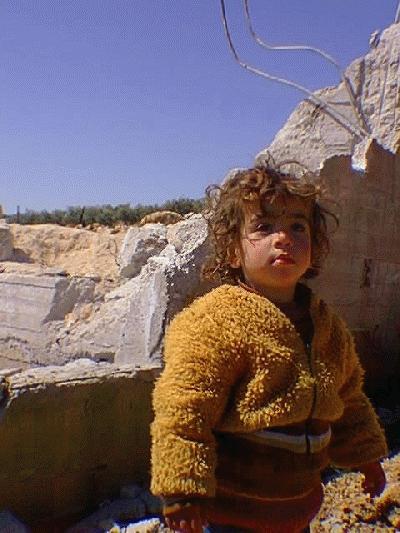|
|
||
Nazati and Taghrite are one family of thirty-eight that have been battling plans to destroy their homes in the al Ram area, between Jerusalem and Ramallah. The residential area in which they live lies just outside of the al Ram municipal borders, and only 300 meters from the nearest illegal Jewish settlement Adam.
More than five hundred people live in this older residential area, but every family who built a home after the Oslo Accord was signed in 1993 has received demolition orders. Every family now awaits the destruction of their homes with increasing dread as further Israeli redeployment seems a distant possibility. The best any of them can hope for is to be included in the next phase of redeployment, which may mean the salvation of their homes. Their story: Nazati and Taghrite lived in Jerusalem's Old City with their five children in a tiny one-room apartment until 1993. They decided to buy land in al Ram, where the prices were good (Israeli law prohibits non-Jews from buying land in Jerusalem and inside Israel). They built a four-room home, about 130 meters square, and put 45,000 Jordanian dinars ($58,500 US) of their savings into its construction. They completed the required engineer's survey and provided land ownership documents to apply for a building permit from the Israeli military authorities for the West Bank. Because they moved into an older residential area where many people already live, they felt confident that they would receive the required permit to build. In 1994 they received a negative response to their request from the Israeli military authorities. The response stated that their home lay in an "agricultural area" according to the archaic and never-updated planning regulations called RJ-5, instituted by the British some 55 years ago. On this basis theirs, and 38 other homes built after the Oslo Accord, were given house demolition orders on or after June 1994. The political basis of these orders is clear: this area lies just outside the al Ram municipal limits (according to RJ-5) but in what is clearly a residential area. The nearby illegal settlement of Adam ALSO lies in an agricultural area (according to RJ-5) but this settlement was not only established on the agricultural lands of al Ram, but also continues to expand. Adam, incidentally, was established on the most fertile lands of this area. In March of 1995, this family appealed to the Israeli High Court against the demolition, and petitioned the Court to include their area in the municipality of al Ram. The court decided to delay the demolition until it heard the case on the town plan. They have not yet heard the case, but since the original petition in March 1995 the Interim Agreement (or Oslo II) was signed in September, and this area fell into the still fully-occupied 70% of the West Bank called Area C. This sealed the fate of these 38 homes. The policy of house demolitions since the signing of the Interim Agreement has taken on overtly political overtones. House demolitions are now focused in areas near Jewish settlements, settler by-pass roads, military installations and the Green Line - all areas over which the Israeli government seeks to maintain permanent control even after the final status negotiations. These families now live in fear. Thirteen homes of the 38 have been destroyed since September 1995, six in 1998 alone. Now settler by-pass road number 45 will run close to this neighborhood, putting more homes at risk. While the High Court has not yet heard the Zarrou case for expanding al Ram's town limits, it appears that the court's decision will depend on the political outcome of the scope of the redeployment from the West Bank. The best that this neighborhood can hope for is to be included in the next redeployment, a slim hope indeed given their proximity to the settlement and the construction of the bypass road. |

